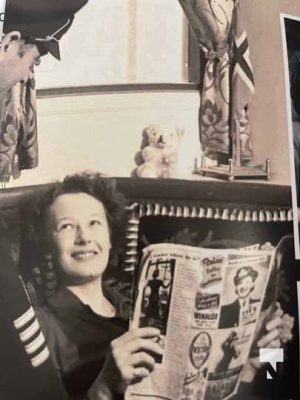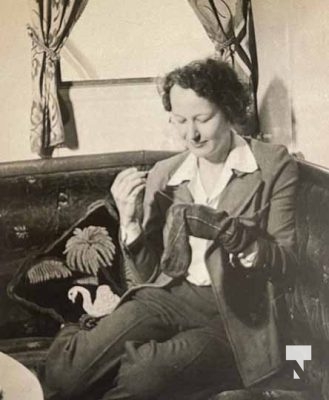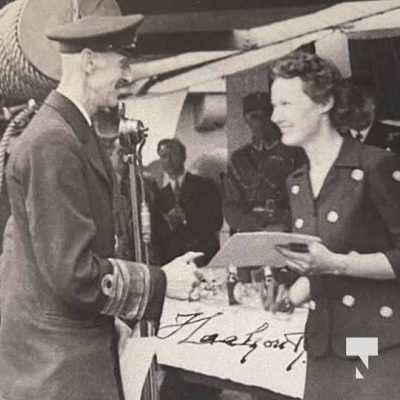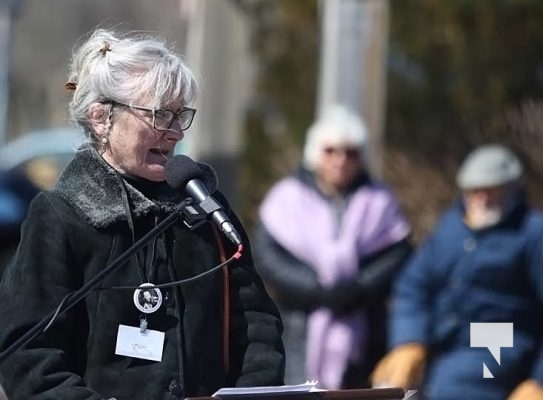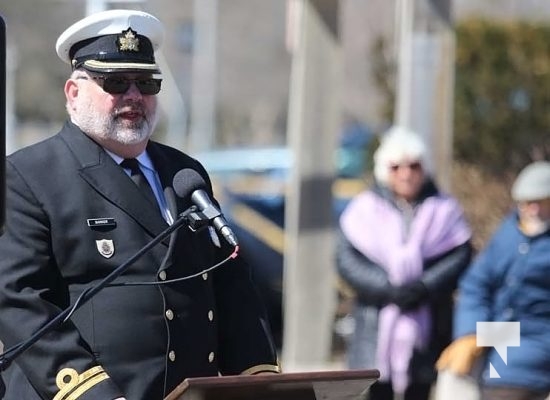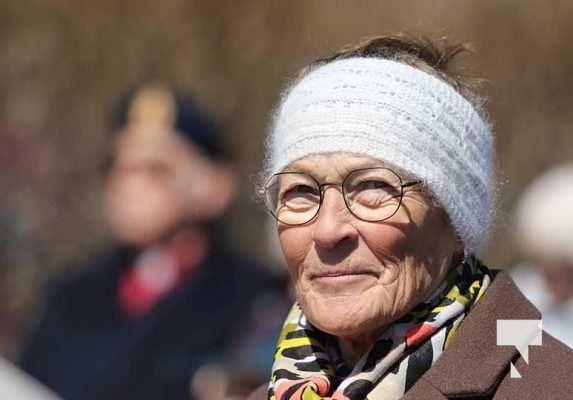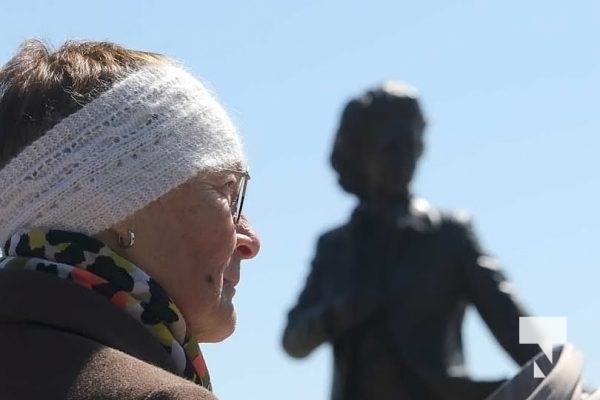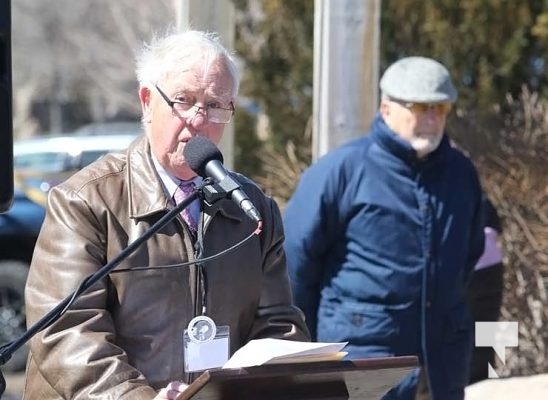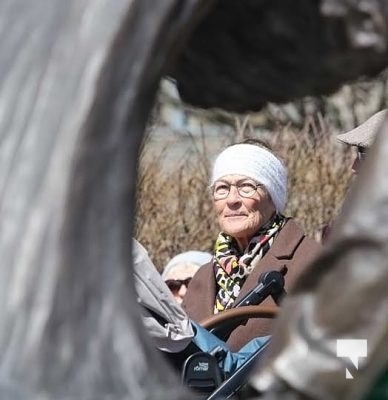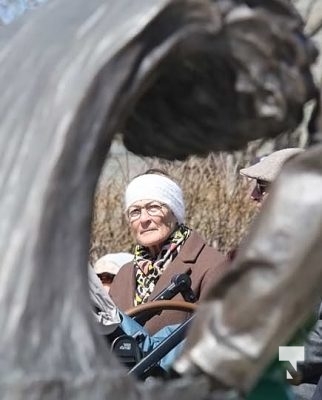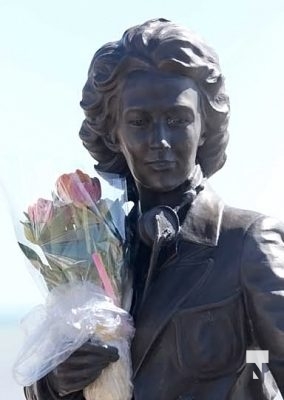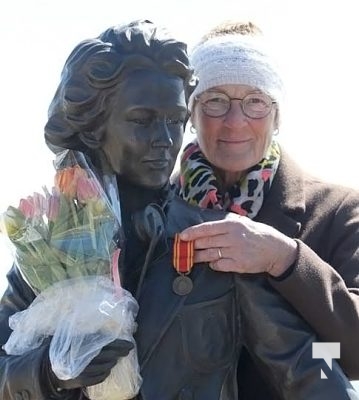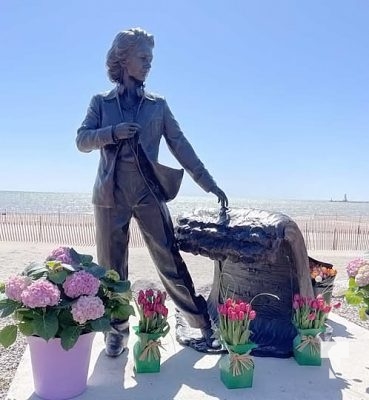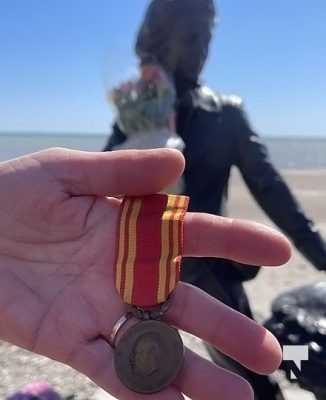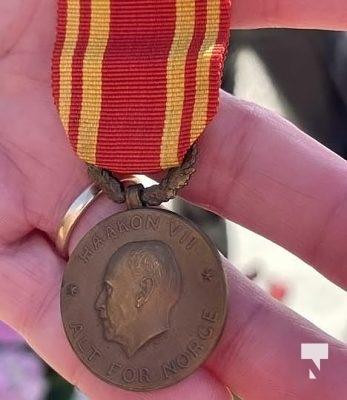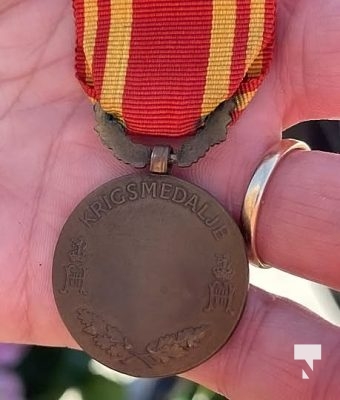
A special ceremony took place at Cobourg’s Meditation Garden, just east of Victoria Park on Sunday, April 2, 2023 honouring a local hero.
Fern Blodgett Sunde was born in Cobourg and became the first Canadian female wireless operator and the first to serve deep see making 78 crossings on the Norwegian merchant ship, the Mosdale, during the perilous Battle of the Atlantic.
A statute was unveiled in October 2020 in the Meditation Garden, but due to COVID restrictions, family weren’t available to attend.
On Sunday, her daughter Fern Sunde Sletten (dag), granddaughter Ingrid (Petter) and great grandson Theodor came from Norway to attend the ceremony.
The committee involved to tell Fern Blodgett Sunde’s story included Lt. (N) Christopher Barker, Petra Becker, Peter Delanty, Laura McCracken Ebbrell, Lynn Hardy, Stanley Isherwood, Art Seymour and Catriona Wood with the support of the Cobourg Museum Foundation.
Below is Fern Blodgett Sunde’s story and speeches from Sunday.
Leona Wood. Chair
We begin our celebration today with the land acknowledgment co-written with the Alderville First Nation.
You will see the flags that have been placed by the Royal Canadian Legion Branch 133, the Canadian Flag, Norwegian Flag provided by the Embassy, the Legion Flag and the White Ensign which was flown in WWII. I would ask the Sergeant at Arms to take the salute.
Thank you
Mayor Lucas Cleveland is the 48th Mayor of the Town of Cobourg and I would like to ask him to come forward at this time,
His Honour the Mayor Lucas Cleveland
“Good afternoon.
I would like to welcome our dignitaries and special guests. Naval Lieutenant Chris Barker, members of the Canadian Armed Forces, Roger Litwiller, Naval historian, past Mayors of Cobourg John Henderson and Peter Delanty.
Welcome members of our Cobourg Council, Randy Barber, Aaron Burchat, Miriam Mutton and CAO Tracey Vaughan.
A special welcome to the family of Fern Blodgett Sunde. Fern’s Daughter, Fern Dunde Sletten and son-in-law Dag, granddaughter Ingrid and her husband Petter, and great grandson Theodor. I would also like to welcome the donors and supports of this project.
We welcome the opportunity to reconvene here with Fern’s family members, and many others who could not be here in October of 2020 due to the many restrictions that were in place at that time.
I welcome you to Cobourg’s Meditation Garden to celebrate the life and accomplishments of Fern Blodgett Sunde.
It is a fitting place indeed for Fern’s statue, created by sculpture Tyler Fauvelle, to have been placed – here overlooking Lake Ontario, as she did as a child. When Fern Blodgett looked at the lake, she dreamt of working on the sea – and as it is written in the history books, she pursued that dream relentlessly.
We remain grateful for the partnership, hard work and the Committee who took an idea of great merit, in memorializing Fern through this statue and saw it through to fruition.”
His Excellency John Elvedal Fredriksen, the Norwegian ambassador could not attend this celebration today as he is hosting the World Curling match between Norway and Canada.
However, he sends his greetings and remembers with fondness the unveiling ceremony in October 2020 when we saw this statue for the first time.
An added feature to this celebration is the Cadet Radio Station which is set up and is transmitting in the Pavilion.
Many of you are here today because you know the incredible story of Fern Blodgett Sunde. You can read some details in the programme but as a summary: Fern and her family moved to Cobourg when she was 6 months old and she often came down to the lake to watch the ships and dreamed of becoming a sailor.
She graduated from high school and went to Toronto to work.
When the war started, she tried to enroll to become a wireless radio operator and was accepted at the third school she applied to. After studying part time she graduated and was hired by a Norwegian merchant ship, The Mosdale, fully loaded and desperate for a wireless radio operator. With great courage, resilience and devotion to duty, Fern made 78 perilous crossings of the Atlantic during WWII. The work that she did, and the subjects that she studied are outlined in detail in the insert in your programme.
In 1943 King Haakon VII of Norway awarded Fern Blodgett Sunde and her husband, Gerner Sunde, the captain of the Mosdale, the Norwegian War Medal. She was the first woman to receive this honour.
Fern left the sea in 1952 to raise her two daughters in Norway, and she stayed in that country after her husband Gerner’s death in 1962.
Fern Blodgett Sunde opened the door to a sisterhood of Sparks, mostly Canadian and Scandinavian women. They followed her to sea. Fern was a trailblazer, a hero. She made waves, and we are pleased to be able to celebrate her achievements today with her family.
The Battle of the Atlantic was the longest continuous battle in
WWII and was crucial to the Allied victory. At one point in the war ships were being lost faster than they could be replaced. Roger Litwiller, a naval historian and author has researched and written about this part of the war for years. We are pleased to have him speak with us today. As he has said, “Fern’s story is the story of the Battle of the Atlantic.
Roger Litwiller
Welcome Sunde family,
-Daughter Fern and her husband Dag,
-Granddaughter Ingrid and husband Peter and
-Their son great grandson Theodore,
Hei velkommen til Canada
Welcome to Canada
Today we are here to celebrate an incredible individual, Fern Blodgett Sunde.
Fern did not plan on becoming a trail blazer. Her story begins the same as many of our own stories. Raised in a small Canadian town, born in Regina and grew up here in Cobourg. When she became a young adult Fern, like all young Canadian women had basically two options available to her.
1. Get married, stay at home and raise a family
2. Or go to work as a housekeeper, secretary or nurse.
Fern opted for work, first training as a nurse and changing to secretarial school. She easily found employment at a Toronto manufacturing firm as a stenographer.
Looking for something more challenging, Fern applied to three wireless schools before finally being accepted to a wireless operator’s course. Radio then was not what we know it as today. Most wireless communication was done by tapping Morse code on a key that transmitted the dots and dashes. The operator would then have to acutely listen for the reply message, recording the individual letters, deciphering the dots and dashes.
Fern was the only women on the course, attending night classes three times a week; she successfully graduated as a Second class wireless operator on 12 June 1941. Within hours of receiving her diploma her instructor called and said there was a ship in Montreal in need of a radio operator. Packing quickly, she boarded a train.
Sailors have been known to be a superstitious lot and having a woman aboard is one of those old superstitions. But having her join the ship on Friday the 13th is a double dose. The skipper of MV Mosdale was Gerner Sunde, a young man to be Captain of a merchant ship, but he had considerable experience, an exceptional sailor and had been fighting this war since the onset. Already upset that he had to delay sailing waiting for a women to arrive, he ordered his ship to get underway.
Within days of Fern joining Mosdale, her story had made international headlines! Newspapers across North America were reporting her story and the first woman “sparker” the nickname for Wireless Operator.
Mosdale made 96 crossings of the Atlantic during the war, Fern was in the ship for 78 of them. A newer ship, having been built in 1939 just before the outbreak of the war, Mosdale was a fast ship for the time; her engines could provide a burst of speed to temporarily outrun a surfaced U-boat.
Occasionally they would join a convoy, one in particular, HX231 came under a ferocious attack by 11 U-boats on 4 April 1943, during the three day battle 6 merchants ships were sunk, 239 merchant sailors were killed. In return the convoy escort sank two of the U-boats.
Because of the ships speed, for most of their sailing, Mosdale travelled alone, independent of the convoys. This was just as dangerous as the convoys, alone on the open Atlantic; no other ships in sight, Mosdale would be the sole target of any U-boat that found them. On one crossing their ship was attacked by enemy aircraft and another they rescued allied merchant sailors who had been torpedoed.
One incident was particularly scary for Mosdale’s crew.
I want you to close your eyes and image you are sailing on the Atlantic, its cold, your ship is heaving under the ocean waves, you have started to become accustomed to the constant rolling as you haven’t used the bucket kept beside your desk in some time. You see nothing, you are alone in a small crowded compartment, just the hum of the radio equipment that fills the space to keep you company. You concentrate on the quiet crackle in your headset as you listen for a radio signal. You feel the constant soothing vibration of the ships engines pushing your ship ever closer to Halifax, now just a day away. Suddenly you hear muffled yelling coming through the steel bulkhead of your radio compartment, the thumping of heavy feet running across the deck, followed immediately by the piercing sound of the ships alarm and the entire ship begins to vibrate as the engines surge with a burst of speed.
Through the voice pipe on the bulkhead the skipper barks out an order to you, Break radio silence, transmit in the clear, submarine surfaced on port bow, give our position. As you start hammering “S S S” in Morse code on the telegraph key, the two guns on deck begin to fire. Your training and experience kick in, every letter of the skipper’s signal has to be sent individually in Morse Code, It seems like forever to send the signal, but with your expertise it has only taken you a few moments to transmit what may be the last message you ever send. Now you wait, the guns have fallen silent; Mosdale engines are working as hard as ever. There is silence on your headset, was your message received, will there be rescue if you are torpedoed.
Suddenly there is a crackle on your headset and a series of dots and dashes come streaming through. You hastily write down the sequence and turn to your codebooks to decipher the message. It is Halifax, your message was received and an RCN escort is being sent to meet you. Just as quickly you inform the skipper of the message. He informs you the U-boat dived when they fired on it.
But you have been found, the enemy knows your location and that you are alone, a sole target on the vast ocean. Knowing the U-boat’s radio operator has transmitted your location to every enemy submarine in the area.
The sailors in Mosdale keep a sharp lookout the rest of the day for the sudden wake of a silent torpedo about to strike their hull, or the U-boat to resurface and engage in a gun battle. Or the saving grace of the RCN escort racing over the horizon.
As the sun begins to set and dusk begins to envelop the ship, the ships guns begin to fire again and the skipper’s voice booms through the voice pipe, send message Submarine spotted on the surface and you begin hammering the telegraph key.
As before the U-boat dived quickly after Mosdale’s guns fired. But now complete and total darkness has blinded the ship.
Fern described this day in one of the interviews she gave after the war, Mosdale and her shipmates survived that night, no other contacts were made with the U-boat.
Despite Gerner’s reservations when Fern first joined his ship in Montreal, they married, during the war. Both were later decorated by the King of Norway for their service in the Battle of the Atlantic.
Following the war, Fern moved to her new homeland with her husband in Norway and began a family.
Today we are celebrating this incredible woman with three generations of Fern’s family.
Today we honour Fern, not as much because she made history as the first woman wireless operator to serve at sea, but more so, because she changed the future, opening doors to many generations of women in Canada and around the world.”
Thank you Roger
This statue is a tribute to the veterans of the Battle of the Atlantic.
Helen Vari, a force to be reckoned with and a trailblazer in her own right, made a significant contribution to the statue and she helped unveil it in 2020. She was always a supporter of veterans, service and education and was a major philanthropist contributing to the causes close to her heart. She wanted to be here today, but unfortunately passed away on March 16 She will be missed, but her legacy is formidable.
Many have passed since we last met in October 2020. I would ask those that are able, to please stand as we hold a minute of silence to remember the veterans of WWII specifically and all those loved ones who are with us now in spirit only.
One Minute of Silence..
Thank you.
At the going down of the sun, and in the morning we will remember them.
Tyler Fauvelle the sculptor of this statue is unable to be with us today, but he sent his remarks, and I have asked a member of the Statue Committee, Peter Delanty to read them.
“Good afternoon.I wish I could be here today, to meet Fern and Gerner’s family in person, but I hope these remarks, as well as the sculpture itself, will speak for me.
I can only imagine the pride you feel in Fern’s accomplishments. She was among Canadians of a towering generation – the men and women who fought and supported a necessary war.
As an artist and as a Canadian, I wanted to express the beauty of Fern’s dedication, her love of the sea, as well as her sheer bravery and trailblazing spirit. To this day, I find it hard to understand what it took for that very young woman to set foot on a ship of strangers, and to make that first voyage at the height of the Battle of the Atlantic. She knew the lethal dangers faced by merchant ships. She also knew that her responsibility was very serious, especially since she was the only radio operator aboard at the time.
Fern was seasick all the way to England, and I think there were bets going around the ship as to whether she would even make the return voyage. But – return, she did. With the most stunning determination, Fern sailed the Mosdale until the end of the war.
The wave Fern touches here symbolizes the wave of social changes which came for Canadian women in the storm of war. The wave also represents radio waves, of course, and the waves of the sea as a battlefield. Finally, the wave refers to “making waves,” the waves Fern made by propelling her way into a profession and onto a battlefield where women were just not allowed, and by jamming a door open for a sisterhood of Sparks to follow her to sea.
At the unveiling, I mentioned that I wanted you, Fern’s family, to know that I understood that Fern’s remarkable story was a love story, too. I lightly traced a wedding ring on her finger, in remembrance of the young Norwegian Captain who had no idea he was hiring his future wife. Together, they faced danger and hardship at sea, and did everything they could to support the Allies in the fight against the Nazis. It touched my heart to hear that Fern said there was only one true love for her, and that she never remarried after Gerner’s death at sea. I thank you so much for sharing your parents’ story, and your family photos.
This monument commemorates a woman who transcended social barriers to contribute to the cause of freedom. Today, we remember that she was also a cherished mother, and a valued member of your family. I hope this sculpture truly reminds you of her, and brings you closer to that brave young woman who followed her dreams to sea.
Thank you, Fern, for your service to Canada and Norway, and for every wave you made.
Thank you all so much. Merci. Tusen takk.”
Program text that was available at the ceremony.
Leona Woods Chair
It is a pleasure to gather once again to celebrate the accomplishments of Fern Blodgett Sunde, a local hero. She was the first Canadian female wireless radio operator and the first to serve deep sea making 78 crossing on the Norwegian merchant ship, the Mosdale, during the perilous Battle of the Atlantic. We also recognize the courage and fortitude of the veterans of the longest battle of WWIl, one that ensured an allied victory.
We unveiled this statue in October 2020. Now, we welcome members of Fern’s family, her daughter, Fern Sunde Sletten (Dag), granddaughter Ingrid (Petter) and great grandson Theodor. They have travelled from Norway to visit the statue and to express their appreciation to the people of Cobourg and Canada for honouring their relative. We welcome them back to the town where Fern grew up and dreamed of being a sailor.
The dedicated statue committee worked tirelessly to make this memorial a reality. We thank all the donors who made financial and in-kind gifts to the project. And we thank all those who shared stories of wireless radio operators, veterans, and pioneers which enriched our journey.
At this celebration we welcome the Skeena Cadets and their compatriots who are running a Ham radio station today. We also welcome the platform party: Mayor Lucas Cleveland, historian Roger Litwiller, sculptor Tyler Fauvelle, and grant writer Debra Dupuis.
We are confident that when people see this statue, read the stories and view the unveiling ceremony at https://www.youtube.com/ watch?v=fWOt2GHmPsQ they will be inspired by the courage, resilience, determination and service of the veterans of the Battle of the Atlantic and of Fern Blodgett Sunde, a trailblazer. She has made the people of Farsund, Norway and Cobourg, Ontario, Canada proud.
Tyler Fauvelle, Sculptor
The Fern Blodgett Sunde monument was created by Tyler Fauvelle, a Canadian professional sculptor, whose work includes more than a dozen public monuments in Ontario, three of which are military commemorations
The Fern Blodgett Sunde monument was sculpted in clay, and cast in bronze at a Canadian foundry.
Fern’s clothing is typical of what she wore as she carried out her duties as a wireless radio operator – a “Sparks”- aboard the Mosdale. The headphones slung around her neck symbolize her profession; the pin on her lapel commemorates the sisterhood of Sparks who followed in her footsteps.
Fern is stepping forward, with one foot emerging from an im-pressionistic wave, but she also looks back, with her hand just grazing the top of the wave. Forward is her persistence in breaking barriers – looking back is remembrance.
The wave symbolizes the wave of social changes which came for Canadian women in the storm of war, radio waves for the Sparks, and the waves of the sea as battlefield. It says: Make waves
Inside the wave, which appears as if the viewer is looking through a window out to sea, reliefs depict merchant ships and naval convoy, in remembrance of all Canadians who served at sea during the Battle of the Atlantic. Two U-boats, lightly outlined at the horizon, represent the danger that claimed thousands upon thousands of Allied lives. The artist leaves it to the viewer to research: Canso amphibious aircraft, SS Athenia, Hawker Hurricanes, HMCS Waskesiu, and HMCS Cobourg.
Tyler hopes that Fern’s story will inspire people of all ages to link arms with her – and make waves.
The Story of Fern Blodgett Sunde 1918-1991
In 1941, during the Battle of the Atlantic, the Admiralty sent a secret letter to The Norwegian Shipping Mission, expressing appreciation of the outstanding services rendered to the Allied cause by three Norwegian cargo ships. The letter praised the ships’ radio operators for the “exemplary manner” in which they followed route instructions and diversions designed to keep the merchant ships out of danger.
The Mosdale, one of the ships being praised, did in fact have a remarkable radio operator. Her name was Fern Blodgett, a young Canadian who was the first woman ever to serve deep sea as a wireless radio operator – a “Sparks”.
Fern grew up in Cobourg, dreaming of sailing the high seas, even though she knew that ships were not for girls. When WWII broke out, she was determined to serve Canada. Although some radio schools were reluctant to train women, she persisted, and became the first Canadian woman to earn a Second Class Wireless Operator’s certificate.
Answering an Urgent call for an operator, she made her way to Montreal. Gerner Sunde, the young Norwegian captain of the Mosdale- and Fern’s future husband – was shocked to see that his applicant was a woman. Neither Canada nor Britain permitted women to work aboard ships at sea. Luckily, Norway had no rule against it. The next thing Fern knew, she was a krigsseiler – a war sailor, the only woman aboard ship, the only operator in a small radio room, where equipment instructions were in languages she didn’t know, where a mistake on her part could send the ship into catastrophe, and where she was horribly seasick.
No one expected her to make the return voyage. With great courage, resilience, and devotion to duty, Fern kept a bucket by her side, and sailed with the Mosdale for 78 of its record 96 transatlantic voyages. It was incredibly dangerous – the sea as battlefield held U-boats, mined waters, surface raiders, fog and terrifying storms. During the early years of the Battle of the Atlantic, ships were going down faster than they could be replaced. Winning the war depended on victory at sea. Along with thousands of Canadians and Allies, Fern did her part during the Battle to keep Allied forces provisioned. In 1943, King Haakon Vil of Norway awarded Fern Blodgett Sunde the Norwegian War Medal – the first woman ever to receive the honour Fern served until the end of the war, and from time-to-time in its aftermath. In 1952, she left the sea to raise her two daughters, Fern and Solveig Ann, and to work in the garden she loved. Fern stayed in Norway after Gerner’s death in 1962. She never remarried.
Fern Blodgett Sunde opened the door to a sisterhood of Sparks, mostly Canadian and Scandinavian women. They followed her to sea, working on Norwegian merchant ships until technology replaced the wireless radio.
Of the ships mentioned in the Admiralty’s 1941 letter of praise, only the Mosdale survived the war.
The Battle of the Atlantic 1939 – 1945
“Without victory, there is no survival.”
Winston Churchill, June 1940, at a moment of crisis during the Battle of the Atlantic
The Battle of the Atlantic was the Second World War’s longest, unbroken battle. It spanned the entire war, ending with Germany’s surrender. Many Canadians aren’t aware of the central role Canada played in this fierce and crucial campaign. In fact, the only Canadian to command a theatre of operations in either WWI or WWII was Rear Admiral Leonard Murray, who took charge of the Northwest Atlantic in 1943.
When Canada followed Britain and declared war on Germany in 1939, Canada’s navy, merchant marine and air force were propelled straight into the battle for control of key shipping routes in the North Atlantic. The Allies fought to keep supply lines to Britain open, and the Axis powers launched a reign of terror to cut those supply lines off, in order to weaken a deprived Britain into submission.
One of Canada’s key roles was escort duty for the hundreds of convoys leaving Halifax and Sydney for the long, dangerous voyage across the Atlantic. Naval and merchant vessels harboured in other busy Canadian ports, such as St. John’s, joined the convoys. The Royal Air Force Coastal Command, which included several Royal Canadian Air Force squadrons, provided aerial cover as far as their range allowed.
The sea as battlefield was merciless – raging storms frequently separated convoys and swamped smaller ships. Sailors who survived the sinking of their ship faced death from hypothermia in the North Atlantic’s cold waters. Ships ran the terrifying risk of mined waters, and of disastrous attack in the dark of night from lethal submarines on patrol. Operating singly, and then in groups called “wolfpacks”, the U-boats sank over 2800 of the 3500 Allied merchant ships lost during the war.
Many Canadians might be surprised to know how close the Battle of the Atlantic came to our shores. German U-boats sank naval escort and merchant vessels in the Gulf of St. Lawrence and St. Lawrence River. For the first time since the War of 1812, fiery warfare was right at Canada’s door.
Eventually, improved equipment, better tactics and technological innovations, along with sheer grit and courage, helped turn the tide in the Allies’ favour. No one knows how many lives the Battle took – the Commonwealth War Graves Commission estimates that the Allied naval services and merchant marine lost more than 80,000 people.
This year is the 75th anniversary of the end of the Second World War. and of the end of the Battle of the Atlantic. The Canadians who served in the Battle of the Atlantic, and the thousands who died in the fight, were among the brave “ordinary men and women who found the courage to do frightening things, pushing themselves beyond their limits, aware that to lose or even draw with the Nazis would leave the world a much darker place.” (Tim Cook, The Fight for History, Penguin Canada, 2020)


